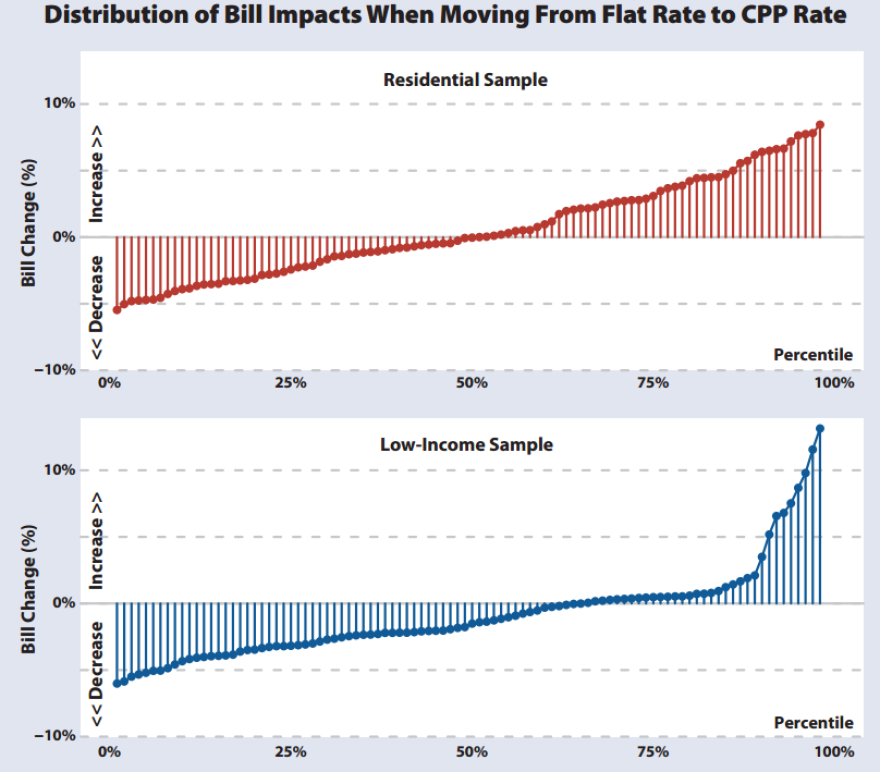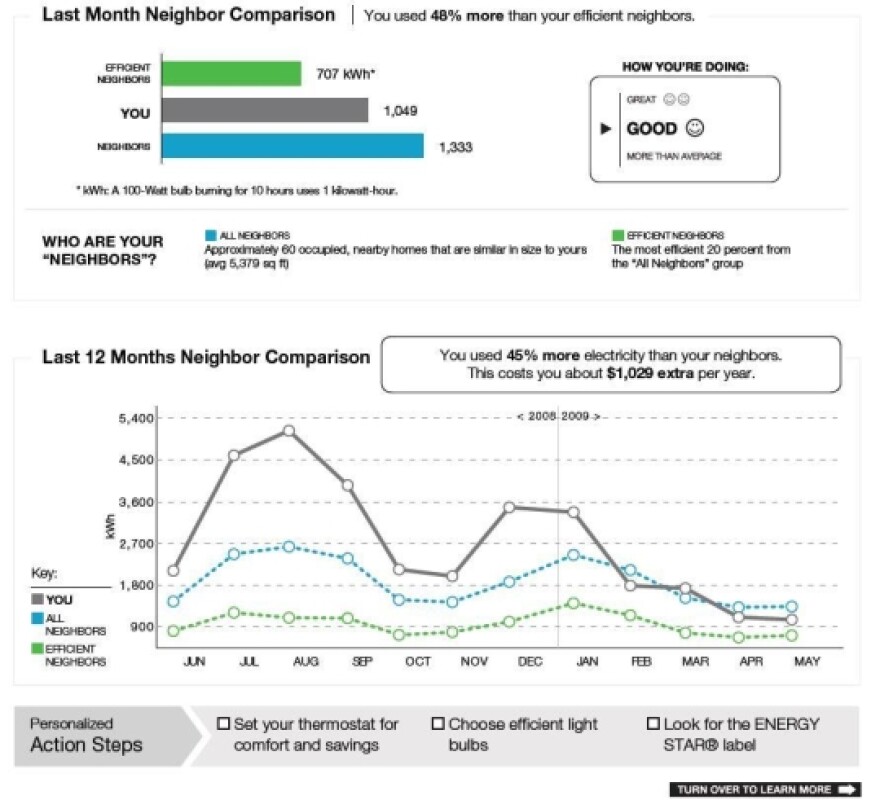New Hampshire’s two largest electric utilities are piloting new billing programs, aimed at getting people to save electricity. These programs could be part of a sea change in the way we are billed for electricity, aimed at encouraging efficiency and conservation. And while convincing Americans to use less energy has always been a bit of a slog, these two pilot programs in New Hampshire hope to change that. One uses the brunt force of economics and the other uses the subtle science of psychology.
“This is telling me that I’m not quite as good as my most efficient neighbors. I use 11 percent more than my most efficient neighbors, but quite a bit less than my neighbors generally,” says Becky Ohler, scrolling through the home energy report that comes as part of the Public Service of New Hampshire pilot she is part of.
The PSNH program is sending about 25,000 randomly selected customers a monthly report. The report she’s getting compares her electricity use to that of a similar house – called a “neighbor” – hoping to nudge you into using less. It also includes a list of things you can try to reduce your consumption and lower your bill.
Ohler is not one of the random recipients, she is a DES employee, and part of a committee that knew this pilot was coming. She was selected to be part of a test group. And yet the “nudge” worked for Ohler.
“I actually was horrified to see this when I first got it,” she remembers, “and I immediately went home and pulled out my refrigerator and vacuumed the coils.”
The nudge doesn’t work on everybody – a study done in California even found that some political conservatives who get the reports actually used more energy – but on average these reports lead to a 2% reduction in energy use.
That might not sound like much, but to those who study energy consumption, it's impressive.
“It’s a humongous number,” says Ahmad Faruqui, who studies electricity billing schemes for the economic consulting firm, the Brattle Group, “If you imagine collectively what all of the energy efficiency programs cost in the US. It’s somewhere upward of $6 billion dollars, and those programs collectively produce a drop of 1%.”
If rolled out nation-wide, these reports could save consumers hundreds of billions of dollars in total, by getting people to save energy, just as environmentalists have been begging for decades.
Dynamic Pricing Flattens Peaks
But it doesn’t directly address another factor of our electric use: the fact that the entire electric grid has to be built up to meet peak demand on the hottest and coldest days of the year. The higher the peaks, the more power plants and power lines we need.
So, the New Hampshire Electric Cooperative’s pilot program is aimed at reducing those peaks.

A small electronic widget sitting on a window-sill in Grace Burson’s home in Plymouth is a the center of this program. It shows how much per hour the total electricity leaving her home is costing.
“It’s currently reading 7.30, 7.37, 7.26 cents per hour, so sometime it will fluctuate that quickly,” says Burson, a pastor and one about 400 volunteers for New Hampshire Electric Cooperative’s Time-Based Pricing pilot.
Under this program customers are charged nearly three and half times more for electricity during the afternoon-to-early-evening, when electricity use is at its peak. The goal is to get consumers to shift to off-peak hours, when cheaper, steadier power plants can fulfill the demand.
“If I need to plug in my phone, if I need to heat a cup of water for tea in the microwave, I do it,” says Burson, when asked how the pilot has changed how she uses electricity, “but I have changed two big energy hogs. I used to run the dishwasher right after dinner, start a load of laundry right after I got home, now I wait until after the rates go down at 8 o’clock.”
These types of programs can chop down peak demand by as much as 4 percent, and careful consumers can also save money.

“What you typically find is that [if you shift your usage] your bill is going to go down as a consumer, somewhere between 5-10 percent,” says Faruqui, who is himself on a time-of-use rate.
These programs are tougher to put in place, though because you need to install so-called smart meters, which can automatically adjust the rate depending on the time of day. The Electric Coop finished putting those in last year with the help of a $15.8 million dollar federal grant.
Ready for the Change?
The question is will American customers accept these trial balloons, since they’re used to not thinking about what time it is before tossing clothes in the dryer, and some might even be annoyed by the extra information in the home energy report.
Time-based prices are already optional in many states around the country, including Vermont, Massachusetts, and Maine, but in most places, very few customers opt in. In Ontario and Italy this type of billing is already mandatory, and there have been no riots. Faruqui thinks the easy way to diffuse any possible anger is to make these programs the default, but to let people opt out.
“In order to have maximum benefits, you need to as many customers in the programs as possible, but if some don’t want to they can always opt out,” he says.
If these programs work according to plan, they can save utilities money too. By reducing their peak demand, they can reduce the amount they pay in fees to regional grid for maintaining power lines.
The Electric Coop’s pilot ends in November, and PSNH will send out its home energy reports until at least next year. After the pilots are done these utilities will have to decide whether to its worth it to them, to roll out to the rest of the Granite State.
**Note: a previous version of this story did not have the number of participants in the NHEC time-based pricing pilot**









